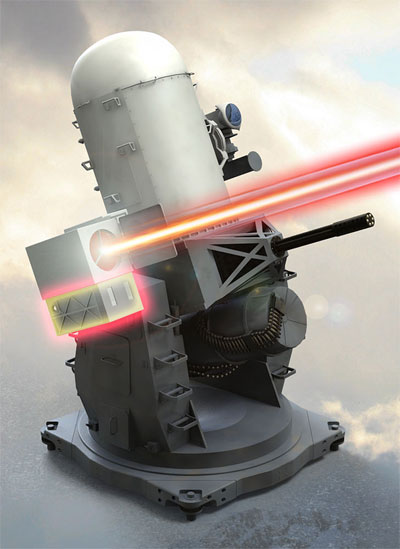US Navy to test powerful, mobile laser weapon against drones
A compact yet powerful laser weapon developed by
Raytheon will soon be integrated on a HMMWV, to demonstrate its ability
to defeat enemy drones, as part of the enhancement of current US Marine
Corps ground-based air-defense capabilities.

Raytheon’s
laser architecture is implemented in a number of directed-energy weapon
applications, including the Laser-Phalanx derivative of the classic
naval Close-In Weapon System. Illustration: Raytheon.
The US Navy Office of Naval Research has awarded
Raytheon US$11 million adapt a tactical
laser weapon
systems to a vehicle-based laser device, capable of defeating
low-flying threats such as enemy drones. For the field demonstration
planned by
ONR Raytheon will integrate a short-range
laser weapon system on a
HMMWV. When systems are fielded they are likely to deploy on the future Joint Light Tactical Vehicle (
JLTV). Some of the system’s components have already been tested under the ‘Ground Based Air Defense (
GBAD)
Directed Energy On-the-Move Future Naval Capabilities’ program,
demonstrating detection and fire control functions of the system, with
the compact phased array radar detecting and tracking UAVs of all sizes.
Later in the year, researchers will test the entire system against
targets using a 10kW laser as a stepping stone to a 30kW laser.
Raytheon will deliver a laser with a minimum power output of 25kW will be used. According to
ONR,
the 30kW system is expected to be ready for field testing in 2016.
Tests will evaluate the complete intercept process, from detection and
tracking to firing, all battle-damage assessment, all based on sensors
and effectors integrated on the test vehicle.

According to Raytheon,
the patented Planar Wave-Guide architecture enables the implementation
of single aperture optical design; without the use of complex optical
beam combining elements, delivering high beam quality, and scalability
beyond 200 kW output power. The design also features efficient heat
removal and thermal management capability, yielding compact size, light
weight and modularity. Photo: Raytheon
“Raytheon’s laser solution generates high power output in a small,
light-weight rugged package ideally suited for mobile platforms,” said
Bill Hart, vice president of Raytheon Space Systems. Raytheon’s
planar waveguide
(PWG) technology is the key to its unique approach to high energy
lasers. Using a single PWG, the size and shape of a 12 inch ruler,
Raytheon high energy lasers generate sufficient power to effectively
engage small aircraft. According to Hart, the technology implemented for
the test is scalable to more powerful systems. “Our PWG laser
architecture is scalable: we can achieve increasingly higher power
levels with the same compact design we’re using for
GBAD.”
he said. With the proliferation of UAVs in the modern battlefield, the
Marine Corps expect that units increasingly will have to defend
themselves against adversaries trying to perform reconnaissance,
surveillance and attack from the air by unmanned systems. According to
Col. William Zamagni, head of
ONR’s Expeditionary Maneuver Warfare and Combating Terrorism Department,
GBAD
will give the Marine Corps a capability to counter those UAV threat
efficiently, sustainably and organically with austere expeditionary
forces. “GBAD employed in a counter UAV role is just the beginning of
its use and opens myriad other possibilities for future expeditionary
forces.”

The
Ground Based Air Defense (GBAD) Directed Energy On-the-Move Future
Naval Capabilities program calls for a field demonstration of a
Humvee-mounted short-range laser weapon system with a minimum power
output of 25kW. The Raytheon-built laser will be packaged to meet the
U.S. Marine Corps’ demanding size, weight and power requirements.
Illustration: Raytheon



![[Image]](http://cryptome.org/2014-info/af-aacp/pict24.jpg)
![[Image]](http://cryptome.org/2014-info/af-aacp/pict17.jpg)
![[Image]](http://cryptome.org/2014-info/af-aacp/pict25.jpg)
![[Image]](http://cryptome.org/2014-info/af-aacp/pict8.jpg)
![[Image]](http://cryptome.org/2014-info/af-aacp/pict9.jpg)
![[Image]](http://cryptome.org/2014-info/af-aacp/pict10.jpg)
![[Image]](http://cryptome.org/2014-info/af-aacp/pict14.jpg)
![[Image]](http://cryptome.org/2014-info/af-aacp/pict18.jpg)
![[Image]](http://cryptome.org/2014-info/af-aacp/pict20.jpg)